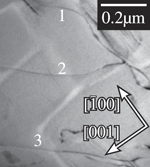Published online by Cambridge University Press: 09 November 2017

Deformation and structural behavior of an experimental γ′-strengthened Co-base alloy during creep at 800 °C and 196 MPa have been investigated. The characteristic features of this alloy are zero γ/γ′-lattice misfit and a fine γ/γ′-microstructure. In the initial condition, the γ′-precipitates in this alloy are small (size of about 100 nm), have polyhedral morphology, and are separated by the very narrow γ-channels (width of about 10 nm). The tests performed up to about 1% creep strain (about 500 h creep time) gave creep curves with a slow constant strain rate and without an apparent transient creep, typical for superalloys with nonzero misfit. In this initial stage of creep, entering of the narrow γ-channels by dislocations is blocked by a strong Orowan force. The micromechanism of creep was identified as an octahedral glide of 〈011〉 superdislocations simultaneously in two phases, γ and γ′. The γ/γ′-microstructure with zero misfit shows no rafting but rapidly coarsens isotropically. It is concluded that zero misfit is beneficial at the initial stages of the creep but is unfavourable for long-term creep because of the continuous microstructural coarsening.
Contributing Editor: Gunther Eggeler